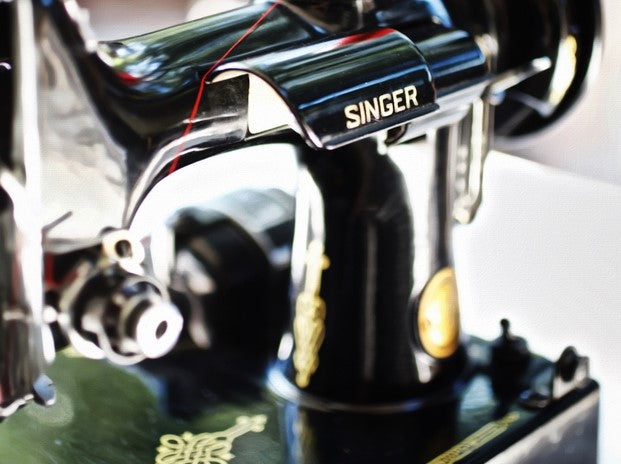Beginners Guide - Sewing Machine Glossary
Here I have gathered some terminology relating to generic sewing machines which will help anyone who owns or wishes to own a sewing machine and needs a little push in the right direction.
Some of the terms below are quite self-explanatory. Refer to the numbers in picture.

1. Tension dial
The dial lets you increase or decrease the tension of your thread. If the tension is too loose it will create stitches that form loops under the fabric. If the tension is too tight it will form loops on the top of the fabric. Adjust this dial as needed but generally is kept at number 4.
2. Presser foot pressure
This can be tightened or loosened depending on the type of fabric you use. Tighten the pressure for tough fabrics like denim and loosen for light fabrics like organza. This setting may not be on all sewing machines.
3. Thread take up lever
4. Thread cutter
Its quite explanatory but I have to say this is a useful little gadget that sits by your side of your machine. Always handy whenever you need to cut thread, be it before threading or after you have finished sewing.
7. Presser foot
This it the foot that is used to hold and guide the fabric through your machine. This foot can easily be changed over to other feet designed especially for specific uses.
8. Needle plate cover
9. Sewing table and accessory box
For those of you who are new to sewing, here is a surprise! There is a hidden little storage box in your sewing machine. Slide it out to the left and the drawer will be visible. Its a great place to keep small handy bits and bobs, like your seam ripper.
10.Stitch width dial
This is a dial that adjusts the width of your stitch. The higher the number the wider the stitch. It is usually adjusted for stitches other than straight stitch but for straight stitching its useful to adjust the needle position!
11.Stitch length dial
This is a dial that adjusts the length of your stitch. The higher the number the longer the stitch. In a zigzag stitch if the length is increased the space between the zigzag increases.
12.Bobbin winder spindle
Everyone will experience an empty bobbin and if you didn't know, there is a handy bobbin winder on your machine to thread your bobbin. Follow the thread placement on your machine then clip the bobbin into the bobbin winder and push it to the far right. This will engage the winder so when you push your foot pedal it will turn the bobbin to fill.
13.Bobbin winder stopper
Once your bobbin becomes full it will cause friction between the thread and the stopper. This shows that the bobbin is now full.
14.Stitch display
15.Reverse lever
Use this lever to back-stitch. Use back-stitching at the start or end of any sewing (unless otherwise stated) to secure your stitches so they don't unravel.
16.Handwheel
While this may seem odd on a electrical machine, its a very useful tool. Use it to lower your needle into the fabric before you start, or when turning corners, and removing it from the fabric at the end of your sewing. It is also used to stitch manually when needed.
17.Patten selector dial
18.Button-hole balance dial
19.Main switch
20.Main plug socket
21.Hole for second spool pin
22.Spool pin
23.Handle
24.Bobbin thread guide
25.Upper thread guides
26.Presser foot lever
Use this lever to lift the presser foot up or release it down. This helps when placing the fabric before stitching and removing the fabric once finished.
27.Drop feed control
This may be the first time you hear this or not know what it is. All sewing machines use feed dogs (the raised, diagonal cut teeth metal bars) which are located around the needle and on the needle plate. These 'feed' the fabric forward (or backward when reversing) and allow it to move smoothly without too much intervention. This lever will drop the dog feeds below the plate so they are no longer influencing the movement of your fabric; this helps when you want to be in complete control such as doing free-hand embroidery.



POST COMMENTS